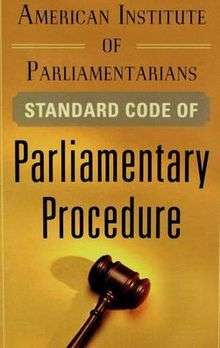The Standard Code of Parliamentary Procedure
 Cover of 2012 edition | |
| Author | American Institute of Parliamentarians, Alice Sturgis |
|---|---|
| Original title | Sturgis' Standard Code of Parliamentary Procedure |
| Subject | Parliamentary Procedure |
| Publisher | McGraw-Hill |
Publication date |
Original Edition: 1950 |
| Pages | 326 |
| ISBN | 978-0-07-177864-0 |
| OCLC | 18765432 |
| 060.42 | |
The Standard Code of Parliamentary Procedure (formerly the Sturgis Standard Code of Parliamentary Procedure by Alice Sturgis) is a book of rules of order. It is the second most popular parliamentary authority in the United States after Robert's Rules of Order.[1] It was first published in 1950. Following the death of the original author in 1988, the third (1988) and fourth (2001) editions of this work were revised by a committee of the American Institute of Parliamentarians. In April 2012, a new book, entitled American Institute of Parliamentarians Standard Code of Parliamentary Procedure (AIPSC) was released.
The Standard Code (TSC) omits several of the motions and sometimes-confusing terminology used in Robert's Rules of Order (RONR). The cover quote of the 2001 edition states, "Anyone who has trouble with Robert's Rules of Order will welcome the simplicity of this streamlined guide to parliamentary procedure." The Standard Code devotes a chapter to the differences between the two works, along with suggestions for those familiar with the Standard Code when participating in organizations that use "Robert's Rules" as their parliamentary authority. AIPSC omits this chapter as well as any other mention of "Robert's Rules".
Robert's Rules of Order versus The Standard Code
| Robert's Rules of Order | The Standard Code | |
|---|---|---|
| Motions in RONR but not in TSC |
Call for the orders of the day | Use informal request or point of order |
| Fix the time to which to adjourn | Instead amend the privileged motion to adjourn | |
| Objection to the consideration of a question | Accomplished by different motions depending on circumstances.[2] | |
| Postpone indefinitely | Use form of table (requiring a two-thirds vote)[3] | |
| Motions with different names |
Previous question | Close debate and vote immediately (or other variations) |
| Concepts in RONR but not TSC | Committee of the Whole and quasi-committee of the whole | Use informal consideration |
| Terminology differences | "Adjourned meeting" resumption of a meeting following an adjournment |
"Continued meeting" |
| Other differences | major differences in the treatment of the motions to reconsider and table; | |
References
Further reading
- Sturgis, Alice (1950). Sturgis Standard Code of Parliamentary Procedure (First ed.). New York: McGraw-Hill. ASIN B000EAC3AQ.
- Sturgis, Alice (1966). Sturgis Standard Code of Parliamentary Procedure (Second ed.). New York: McGraw-Hill. ISBN 978-0-07-062272-2.
- Sturgis, Alice; American Institute of Parliamentarians (1988). Standard Code of Parliamentary Procedure (Third ed.). New York: McGraw-Hill. ISBN 978-0-07-062399-6.
- Sturgis, Alice; American Institute of Parliamentarians (2001). The Standard Code of Parliamentary Procedure (Fourth ed.). New York: McGraw-Hill. ISBN 978-0-07-136513-0.
- American Institute of Parliamentarians (2012). American Institute of Parliamentarians Standard Code of Parliamentary Procedure. New York: McGraw-Hill. ISBN 978-0-07-177864-0.
- Education Department, American Institute of Parliamentarians (2014). AIP Standard Code of Parliamentary Procedure Workbook: A workbook for users of American Institute of Parliamentarians Standard Code of Parliamentary Procedure. American Institute of Parliamentarians.
- Glazer, Barry; Education Department, American Institute of Parliamentarians (2015). Differences Between AIPSC and RONR. American Institute of Parliamentarians.
- Education Department, American Institute of Parliamentarians (2015). Here is the Answer! What is the Question?: Book 6, Covering American Institute of Parliamentarians Standard Code of Parliamentary Procedure. American Institute of Parliamentarians.